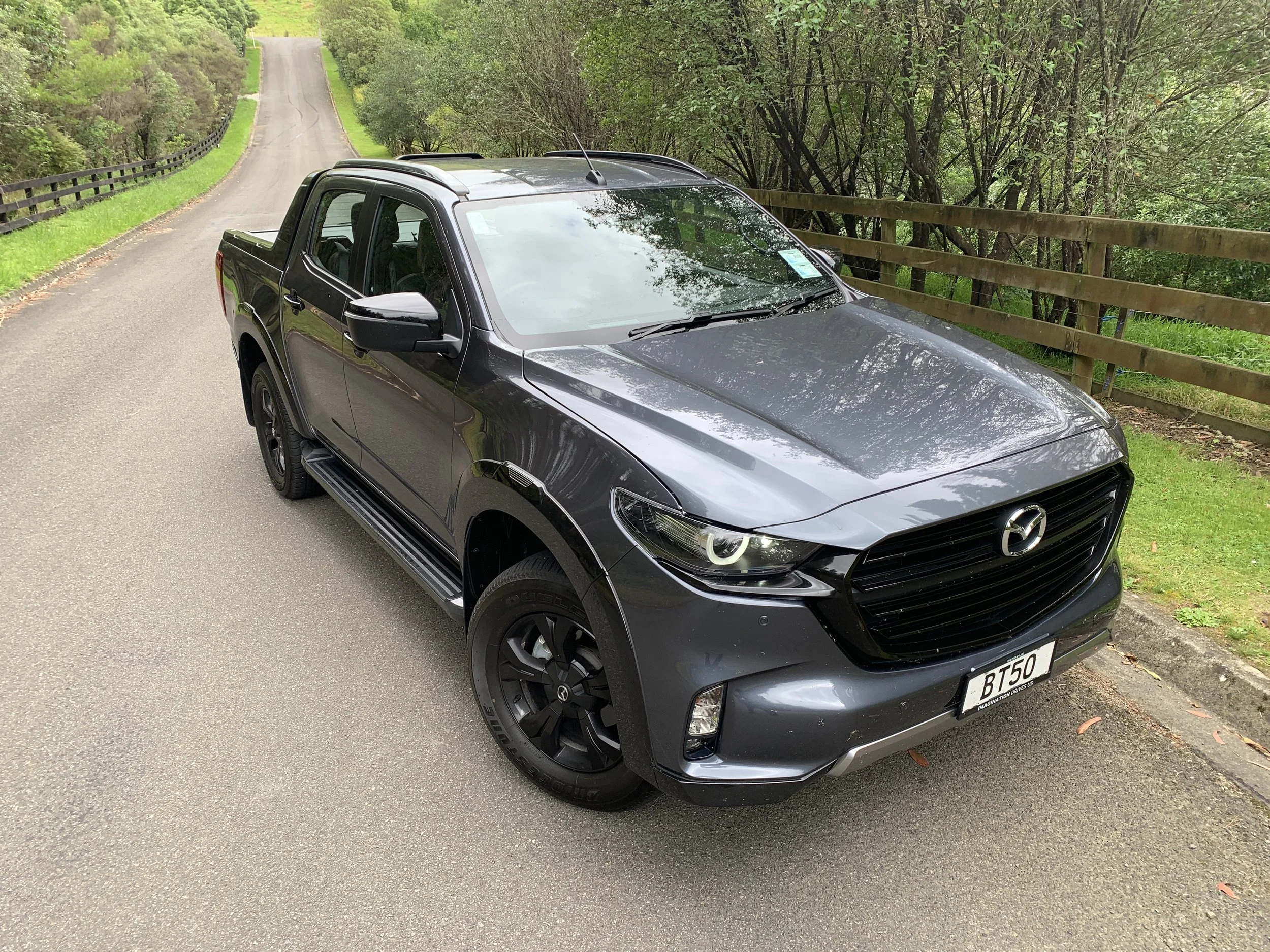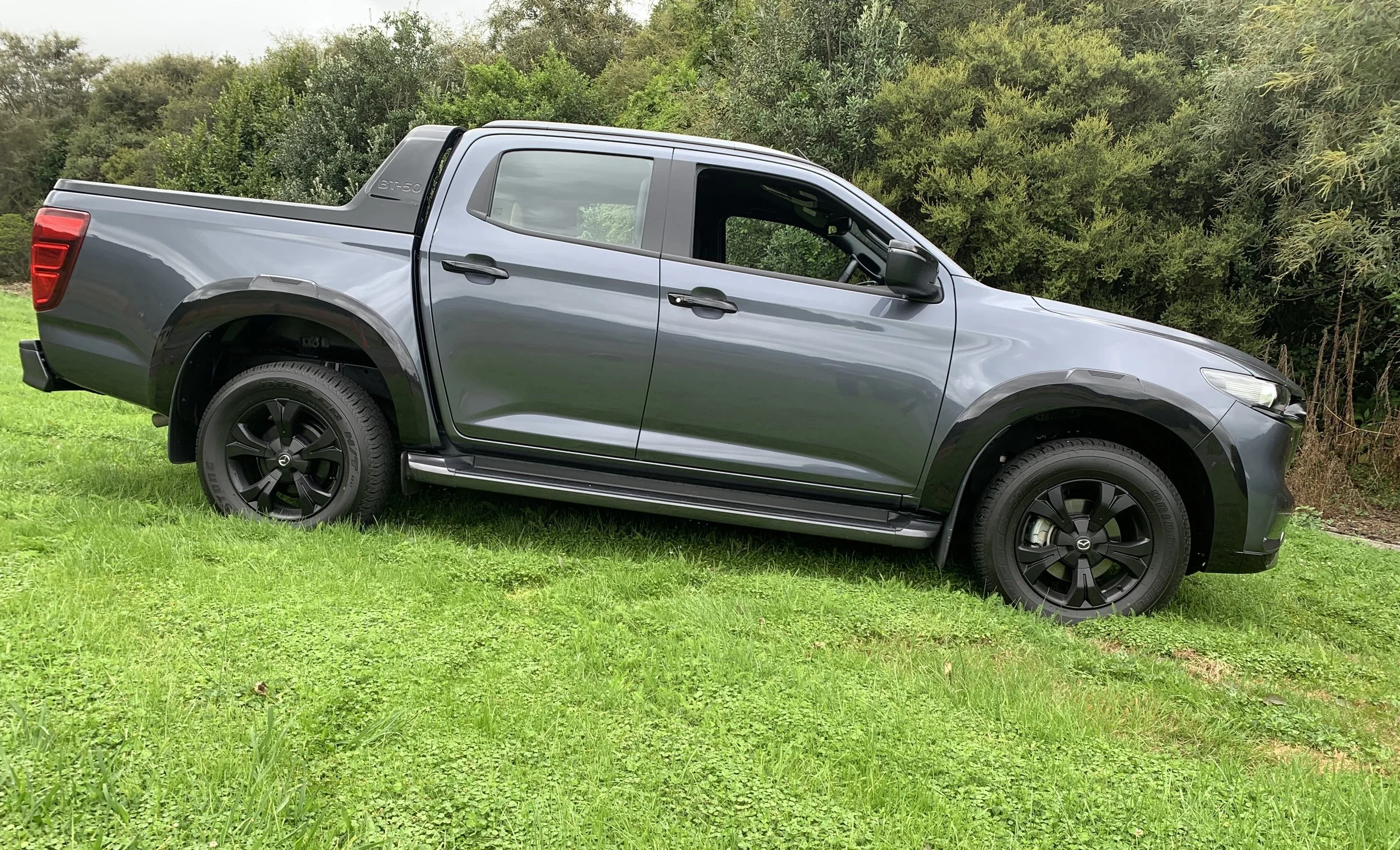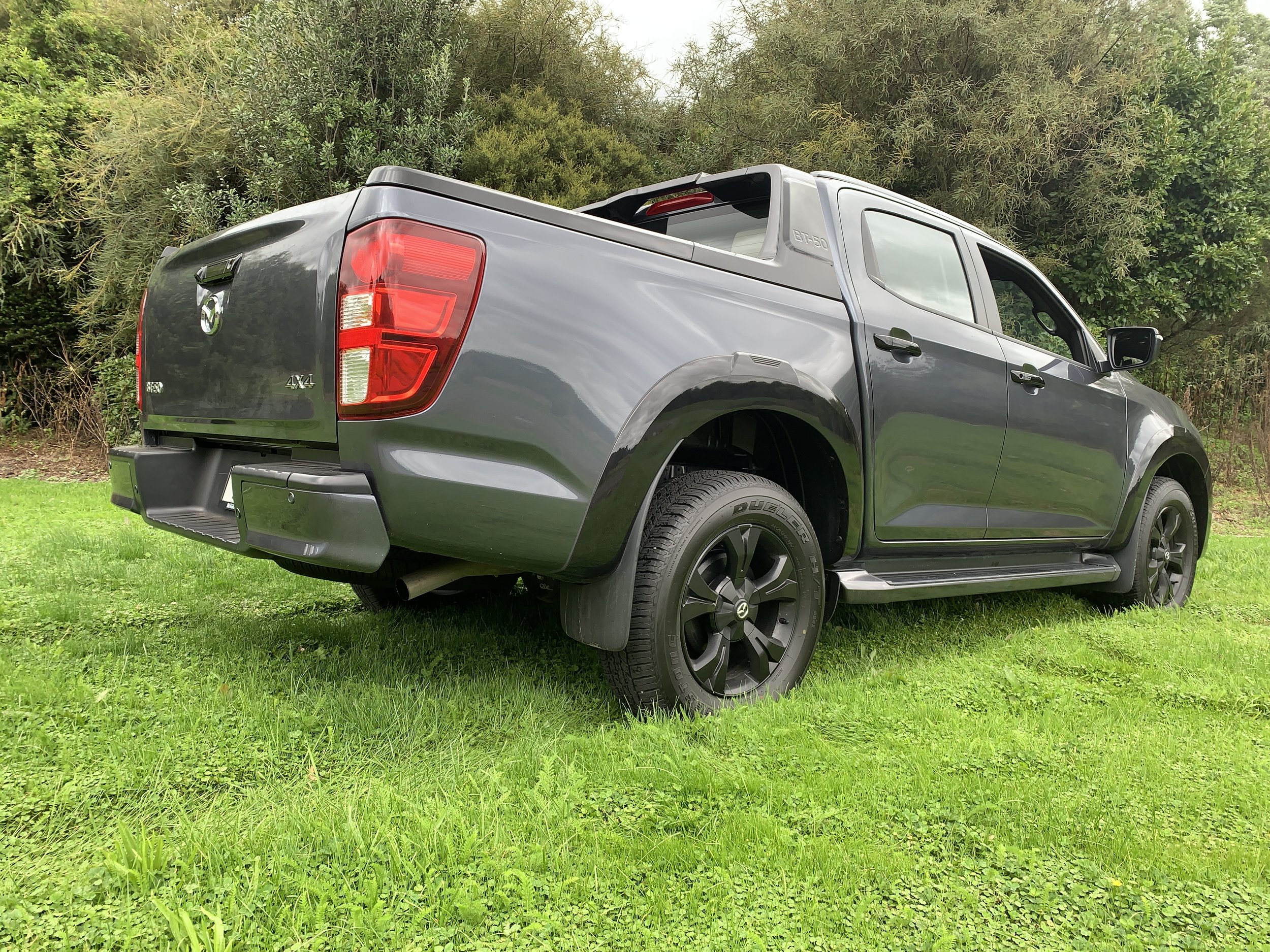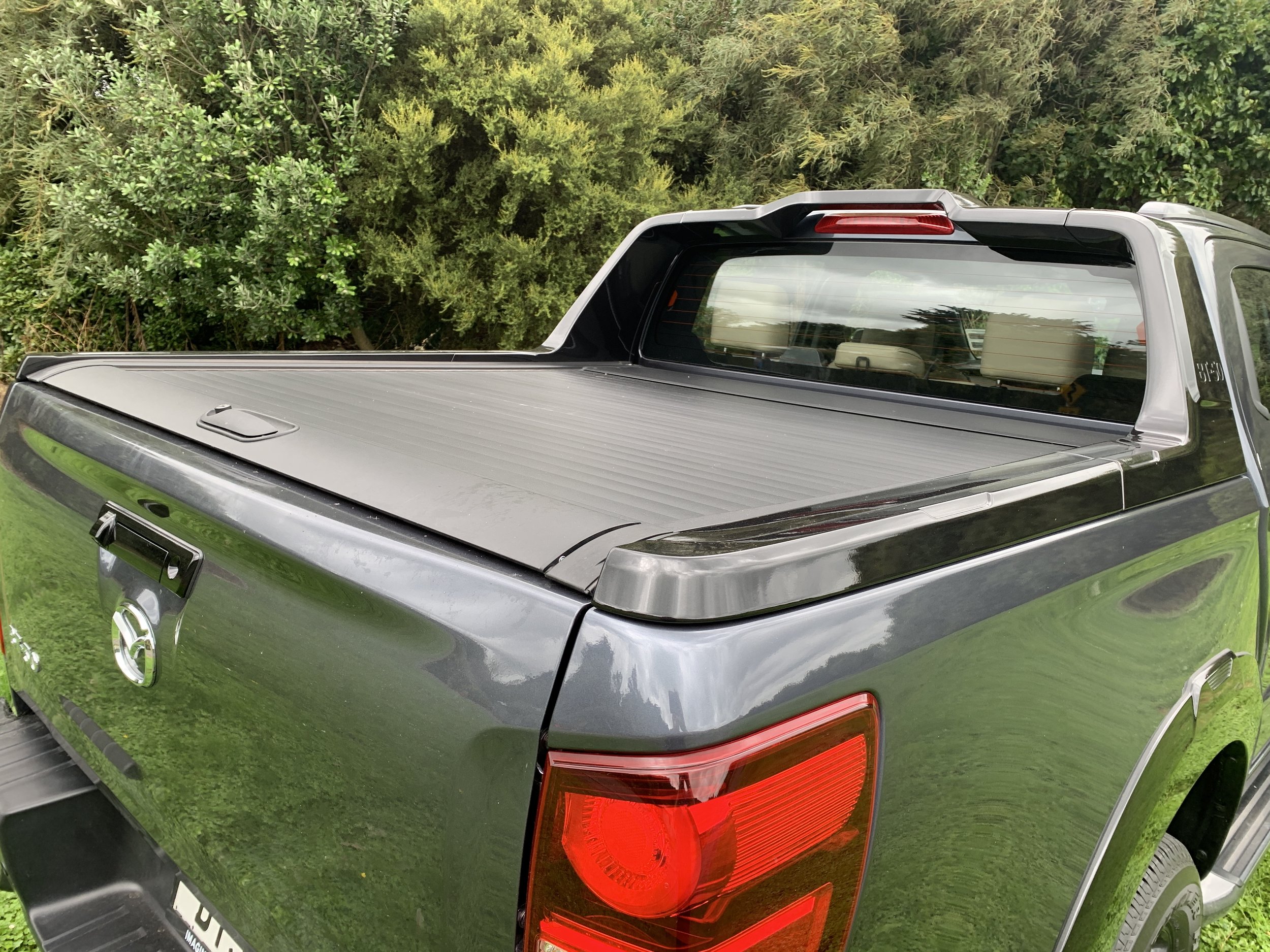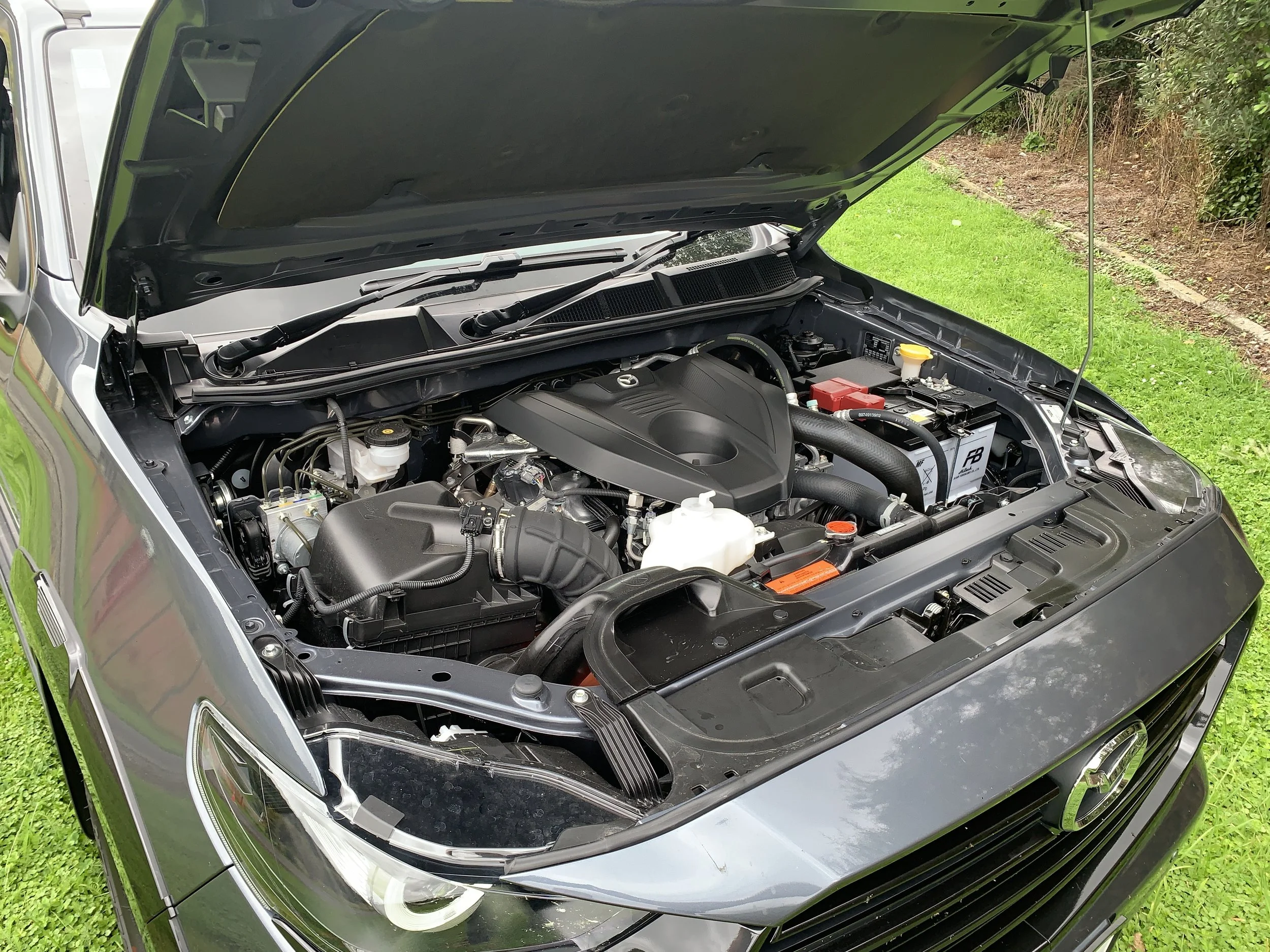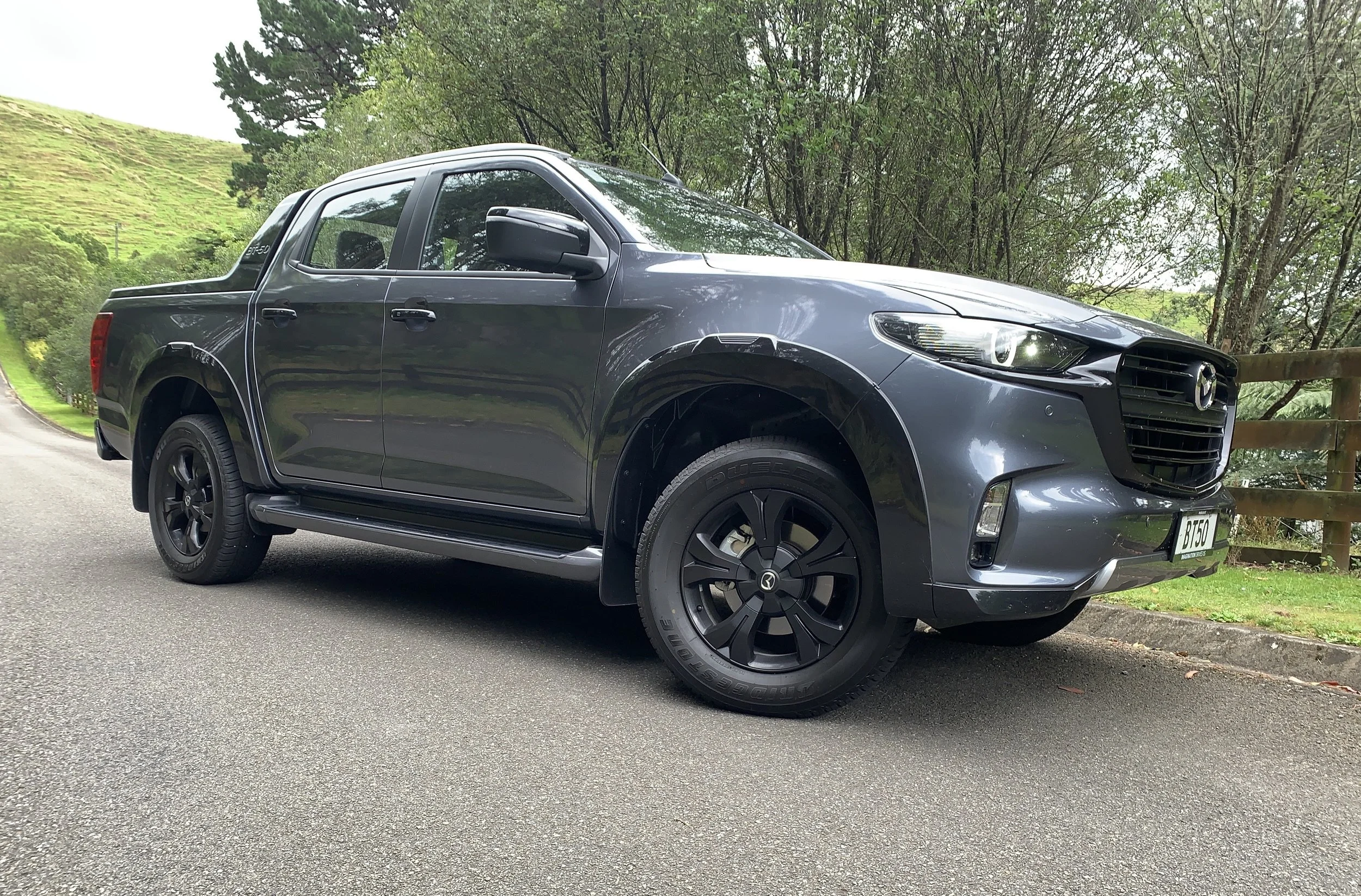Mazda BT-50 Takami roadtest review: Trayed special
/How much pampering can a rugged character stand?
Price: $68,690
Powertrain and economy: 3.0-litre turbo diesel four, 140kW/450Nm, six-speed automatic, part-time 4WD, 9.2l/100km (NEDC), CO2 238g/km (3P-WLTP)
Vital statistics: 5280mm long, 1870mm wide, 1800mm tall.
Safety: Five stars ANCAP.
We like: More sensibly priced than some swanked-up utes, handsome looks.
Not so much: Tow bar should be included, centre screen operability,
IF ‘ute tax’ has so far proven anything, it’s to show how hard it is for Kiwis to shake addiction to one-tonne traydecks.
For almost a year now buyers have been hit by an emissions penalty on their choices – and what could have been unpalatable hasn’t.
All the angst about how Clean Car would kill interest has come to nothing. Sales rates and buying trends remain strong. Ute buying only faltered briefly post April 1 because stocks ran dry for a period. A repercussion of those pre-April 1 ‘buy now, avoid the tax’ campaigns.
Is this an Indian Summer? For all the insouciance to Clean Car penalties that now load, on average, around $3000 to ute stickers, don’t doubt the seriousness of the legislative effort to reduce fleet CO2; which utes do tend to pump out in high count.
The Clean Car Standard is now in play and it’s hard to see how it cannot ultimately influence and cause second thoughts. The difference between it and the Clean Car Discount to which we’re seemingly inured is huge. Whereas last year’s action was designed to encourage consumers to buy cleaner vehicles, the Standard is designed to ‘encourage’ the industry to sell them. It’s encouragement with a large stick.
Under the Standard importers are required to meet average CO2 targets for the vehicles they bring in, which will get progressively lower until 2027.
Distributors in position to offset their higher-emitting vehicles with cleaner cars will feel less impact than those who cannot. Yet the targets are aggressive and, essentially, it will be very hard for brands to meet their targets without increasing reliance on electrified vehicles.
From 1 January, imported vehicles have incurred either a credit or a charge based on CO2 emissions. Utes are high CO2 vehicles, so are impacted by extra costs and while payment of charges has been deferred until June to ensure a smooth implementation for the industry, distributors are putting funds aside to cover the first half of the year. Those who do well from high CO2 fare are nervous. The more ‘miscreant’ vehicles sold, the more they pay.
Or, rather, you pay … because while the brands will fork out, those that cannot achieve the Standard have said they will pass on the cost to the end purchaser. And, yes, this is additional to the penalty incurred already. Some higher-emitting vehicles WILL become substantially more expensive.
In the here and now, the big gun brands are still the big gun brands. Ford Ranger dominated before. It continues to dominate now; to point of being in 2022 the country’s best-selling new vehicle, a continuation of a trend. Toyota Hilux remains the bridesmaid. And Mitsubishi’s Triton is holding third as steadfastly as ever. Ute registrations for 2022 weren’t as strong as the two previous years, but they were still extremely healthy.
There’s argument that this ongoing support reminds just how vital utes are to our way of life. And work. In all likelihood, ute buying will ramp up in wake of Cyclone Gabrielle; they’re perfect vehicles for clean-up duty. Even Government accepts that. They’re said to be keen to buy a heap more.
On the other hand, the type of ute we’re buying hardly supports the ‘toil-first’ logic. Doublecab diesel, with automatic transmission, four-wheel-drive and a big dollop of premium gear; that’s the formula for success in this sector. The average unit spend sits above $80,000. And most buyers like to lavish their rigs with accessories.
Hardly surprisingly, then, that Mazda New Zealand has locally created the BT-50 Takami; a derivative that additional plush to the Limited version that’s the factory’s top effort.
Takami is all about turning heads. Hiroshima’s Isuzu-derived truck is not by any means the highest volume contributor to the one-tonne ute carpark, so anything with potential to raise interest has to be worth trying.
Time spent at the wheel was informative. You’d struggle to call BT-50 the best-developed ute in the sector. Though marriage with Isuzu (after divorce from Ford) has created a stronger model in this generation, when it comes to dynamic, performance, refinement and design merit, the Blue Oval’s newest Ranger continues to impress as the category barometer.
Yet, if it comes to seeking plush for less premium, then the Mazda potentially stands out as a canny purchase. In addition to shaping up against the no-longer-related Ranger and second-strongest selling Hilux, the latest Mazda ute already looks handy in undercutting its new twin-under-the-skin, the Isuzu D-Max, despite a slight price increase over the old model. That price advantage carries to the Takami - one of the better dressed offers yet, at same token, among the least expensive. A sub-$70k sticker looks pretty alluring when most obvious rivals are in much rarer air.
We say Takami. In other markets Mazda has Takumi. Both ways, it spells out to a top-level treatment. Perhaps they’re heading into the same space. The new CX-60 incoming later this year has Takumi provision. It won’t really matter: They both kinda mean the same thing.
Specifically, Takami translates as “higher” or “a level above”. A good play for a ute, given the generous ground clearance and imposing stance. Of course, it doesn’t physically stand taller than any other BT-50. Engine power, suspension tune … none of that stuff alters. Takami’s point of $6500 difference above Limited is wholly cosmetic. The plus out of the programme is that the value it delivers in visual improvement alone is greater than the dollar spend. Save in one respect. I’ll get back to that.
Trimming to add extra luxury is interesting, and surely reflective of NZ taste; some ute old hands would say it’s better to add additional toughness. That’s what Toyota NZ did to create the Hilux Mako – 200 sold and only curtailed when the donor derivative altered to point the localised bits didn’t fit.
It’s what Mazda Australia did to create their own in-house special BT-50. The ‘Thunder’ that sold across the Tasman was specifically concocted to enhance off-roading status; adding in additional ride height, tougher body protections – including a bull bar front end – and more rugged rubber.
Here it’s all about a smooth look. It’s big on gloss black. That’s the hue for the signature Mazda family grille, the enhanced wheel arch flares that envelope the 18-inch alloys, the mirror caps and door handles. The side steps and roof rails, meantime, go gunmetal grey and silver. There’s a sizeable BT-50 embossed sail plane (aka a sports bar) behind the cabin. All these, plus the spring-loaded roller lid for the deck, can be sourced as either factory options or after-market accessories for the cheaper models, but are more expensive to buy that way.
So it’s got all that. And I haven’t even mentioned the tow bar. Because? Well, because that’s the one item it doesn’t get. Which perplexes me. Utes are about utility. Which means practicality. Which not only means hefting stuff on the deck. In my book, it also means a hauling. The Takami will take the factory tow kit, no problem. But you’ve got to pay extra for it. Missed opportunity, I’d say.
Look inside and there’s just a single change; the leather upholstered interior being presented in a khaki hue similar to that commonly seen in Takami grade cars. Aside from this, the cabin spec apes that of the Limited grade which means heated front seats, power adjustable driver’s seat and eight-speaker audio system among ingredients.
The nine-inch infotainment screen is good-sized and sites neatly, but previous thought about the operating system and graphics still stand. It’s just all a bit too B-grade in respect to the typefaces and the operability. The one saving grace is that it supports phone projection; though even that is a faff to get into and run – though connection is wireless, a cable still needs to involve to keep your phone juiced. But at least you know where you are with Apple Carplay.
With all the comforts, it’s a flash looking truck. All the same, when Mazda and Isuzu formed their union, it was on understanding the latter would take the lead and that’s led to certain outcomes because, of all the mainstream ute makers, Isuzu has always been most dedicated to old school principles.
The previous D-Max was emphatically workhorse, the new that forms the basis for the BT-50 has picked up a lot of fancy gear – not least in respect to safety aids and driver assists – that truly make it a good bet for family use.
But it still isn’t a show pony by any stretch. There’s no chance, then, of even a Mazda with all the comforts was ever going to break away from that heritage.
You see evidence of this in the cabin: The interior feels well made, with acceptable fit and finish and a durable feeling to workmanlike plastics on the dash and console leaving impression it should be able to cope with what families and workers will throw at it. Also in driving and in the design. Yes, there are some quirks, but no argument, this BT-50, through having steered clear of the old model’s over-ambitious creativity, is a far more handsome proposition. And yet …
Well, it’s a ute. One that’s not outright rudimentary. But the sense of robustness is pervading. There’s never any doubting what it is you’re driving. Some utes feel less ute-like than others; this one never leaves any doubt about what its primary role is.
Honestly, that’s fine by me. Smartly dressed and appointed utes are to be celebrated, but there’s no point raising the standard and losing the core appeal.
So what that you don’t get so don’t a pampered limousine-style ride? It’d be more disturbing were that the case. As is, the ride is decent, but you can still tell it's a ute and expect jitters from the three leaf-sprung rear end without a load on board. I swear you could almost hear it utter a celebratory whoop when we used it one Saturday morning to fetch a load of crushed lime from the garden centre, having first taken precaution to protect that deck with a tarp – a plastic liner is part of the kit, but when you’re playing with someone else’s toy, it’s only right to be a tidy Kiwi. The weight was just enough to drop the rear end a touch, but the vehicle as a whole felt more settled and was utterly unfazed otherwise and, straight away, the ride was less crashy.
The deck design is deep but not overly wide; a pallet won’t slip between the wheel-arches as with the Ford Ranger. Equipping with the rollaway cover further restricts this. Fortunately, we had a good loader driver; she had everything perfectly sussed, but even that experience made me wonder about the practical limitations of the lid. I get that, as a lockable item, it turns the deck into a secure locker and, when it’s closed, it might have some aero benefit. On the other hand, even though it can be removed, that wouldn’t be a job of the moment. Restoring it might be worse.
Driving-wise, it’s a vehicle that doesn’t mind being driven briskly, but isn’t the best for pushing hard. I like the steering; going from a hydraulic system to an electric setup with this generation makes the action considerably more driver-friendly than it was before. There’s still lots of feel and feedback through the wheel, but it’s no longer such a muscle-builder. You notice this especially in urban use. The turning circle is still large at 12.5 metres and it still takes quite a few turns lock-to-lock, yet it’s less of a chore.
The 3.0-litre turbo-diesel four is a re-engineering of a unit that’s been an Isuzu staple for a few years now. It’ not lacking for oomph. The torque delivery is impressive from low speed, with 450Nm from just 1600rpm (another reason why it seems almost criminal it doesn’t have a tow bar). Would you have this over Ranger’s 2.0-litre biturbo? Quite likely. What about the V6? Yeah, that’s a harder one.
The Blue Oval unit is also old – it started out with Peugeot many moons ago – but it’s as muscular and went to a much higher class finishing school. It’s a lot more refined. With the Maz-suzu, there’s no arguning that with this brawn comes significant bombast. There’s rarely a quiet moment; not least at start-up. Significant clatter when cold is a trait it just cannot shake. At least it’s not a heavy drinker. A week of mixed condition driving delivered an average of 8.9 litres per 100km. Not bad, all in all.
Sticking with a six-speed auto when rivals have gone to eight- and 10-speed units might seem a pointer to a limited development budget, yet it seems to do the job adequately well, but no more than that. It can jolt when dropping a ratio or two down hills for additional engine braking and seemed too keen to shuffle between top and fifth at higher speed.
The four-wheel-drive mode actions are nicely done. The smoothness in which it will engage in and out of four high from rear-drive at reasonable clip is impressive; the lack of hesitancy will be appreciated by those driving gravel roads that are interspersed with short stretches of seal.
Dropping into low range is also less finicky than before. Select neutral, push and twist the knob and seconds later it is engaged. As on the ute, the diff lock is a bit fussier about if and when it would activate. But you’ll put up with that because it’s a great asset.
BT-50 stands among the smartest guys in a crowded room when it comes to occupant protection, with eight airbags, autonomous emergency braking, stop/go adaptive cruise, blind spot detection, lane departure warning/assist, forward collision avoidance, drive attention warning, automatic high-beam lights, rain-sensing wipers and a reversing camera. Perhaps one of the most interesting inclusions is the front-centre airbag - to protect those in the front seats in the event of a side impact and required for a five-star ANCAP rating.
The Takami presents enough of a price jump over the Limited that it’s going to make some think it more logical to save dollars and stop with the factory’s finest. On the other hand, if someone doe want to splash out, then they’ll find this special mostly does the business. Give it a tow bar and all boxes are ticked.
If cross-shopping, it looks good against the closest-equivalent Isuzu D-Max and also stands up pretty well on those aspects of tech, kit and competence when pitching against some bigger sellers in the category, though comparison on the performance side is less noteworthy.
The ute sector has been a goldmine for years, now. How much longer it’ll remain that way is anyone’s guess. Old habits.

